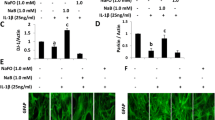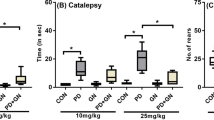Abstract
Parkinson’s disease (PD) is the second most common devastating human neurodegenerative disorder and despite intense investigation, no effective therapy is available for PD. Cinnamic acid, a naturally occurring aromatic fatty acid of low toxicity, is a precursor for the synthesis of a huge number of plant substances. This study highlights the neuroprotective effect of cinnamic acid in 1-methyl-4-phenyl-1,2,3,6-tetrahydropyridine (MPTP) mouse model of PD. Oral administration of cinnamic acid protected tyrosine hydroxylase (TH)-positive dopaminergic neurons in the substantia nigra pars compacta (SNpc) and TH fibers in the striatum of MPTP-insulted mice. Accordingly, oral cinnamic acid also normalized striatal neurotransmitters and improved locomotor activities in MPTP-intoxicated mice. While investigating mechanisms, we found that cinnamic acid induced the activation of peroxisome proliferator-activated receptor α (PPARα), but not PPARβ, in primary mouse astrocytes. Cinnamic acid mediated protection of the nigrostriatal system and locomotor activities in WT and PPARβ (–/–), but not PPARα (–/–) mice from MPTP intoxication suggests that cinnamic acid requires the involvement of PPARα in protecting dopaminergic neurons in this model of PD. This study delineates a new function of cinnamic acid in protecting dopaminergic neurons via PPARα that could be beneficial for PD.







Similar content being viewed by others
References
Mhyre TR, Boyd JT, Hamill RW, Maguire-Zeiss KA (2012) Parkinson’s disease. Subcell Biochem 65:389–455
Wyss-Coray T (2016) Ageing, neurodegeneration and brain rejuvenation. Nature 539:180–186
Postuma RB, Berg D, Adler CH, Bloem BR, Chan P, Deuschl G, Gasser T, Goetz CG, Halliday G, Joseph L, Lang AE, Liepelt-Scarfone I, Litvan I, Marek K, Oertel W, Olanow CW, Poewe W, Stern M (2016) The new definition and diagnostic criteria of Parkinson’s disease. Lancet Neurol 15:546–548
Opara JA, Brola W, Leonardi M, Blaszczyk B (2012) Quality of life in Parkinson’s disease. J Med Life 5:375–381
Schrag A, Choudhury M, Kaski D, Gallagher DA (2015) Why do patients with Parkinson’s disease fall? A cross-sectional analysis of possible causes of falls. NPJ Parkinsons Dis 1:15011
Diederich NJ, Fenelon G, Stebbins G, Goetz CG (2009) Hallucinations in Parkinson disease. Nat Rev Neurol 5:331–342
Hindle JV (2010) Ageing, neurodegeneration and Parkinson’s disease. Age Ageing 39:156–161
Seibyl JP, Marek KL, Quinlan D, Sheff K, Zoghbi S, Zea-Ponce Y, Baldwin RM, Fussell B, Smith EO, Charney DS, van Dyck C et al (1995) Decreased single-photon emission computed tomographic [123I]beta-CIT striatal uptake correlates with symptom severity in Parkinson’s disease. Ann Neurol 38:589–598
Ellis JM, Fell MJ (2017) Current approaches to the treatment of Parkinson’s Disease. Bioorg Med Chem Lett 27:4247–4255
Kowal SL, Dall TM, Chakrabarti R, Storm MV, Jain A (2013) The current and projected economic burden of Parkinson’s disease in the United States. Mov Disord 28:311–318
Adisakwattana S (2017) Cinnamic acid and its derivatives: mechanisms for prevention and management of diabetes and its complications. Nutrients 9:163
Liu L, Hudgins WR, Shack S, Yin MQ, Samid D (1995) Cinnamic acid: a natural product with potential use in cancer intervention. Int J Cancer 62:345–350
Guo JP, Yu S, McGeer PL (2010) Simple in vitro assays to identify amyloid-beta aggregation blockers for Alzheimer’s disease therapy. J Alzheimers Dis 19:1359–1370
Hemmati AA, Alboghobeish S, Ahangarpour A (2018) Effects of cinnamic acid on memory deficits and brain oxidative stress in streptozotocin-induced diabetic mice. Korean J Physiol Pharmacol 22:257–267
Jackson-Lewis V, Przedborski S (2007) Protocol for the MPTP mouse model of Parkinson’s disease. Nat Protoc 2:141–151
Chandra G, Roy A, Rangasamy SB, Pahan K (2016) Induction of adaptive immunity leads to nigrostriatal disease progression in MPTP mouse model of Parkinson’s disease. J Immunol 198:4312–4326
Khasnavis S, Pahan K (2014) Cinnamon treatment upregulates neuroprotective proteins Parkin and DJ-1 and protects dopaminergic neurons in a mouse model of Parkinson’s disease. J Neuroimmune Pharmacol 9:569–581
Khasnavis S, Roy A, Ghosh S, Watson R, Pahan K (2014) Protection of dopaminergic neurons in a mouse model of Parkinson’s disease by a physically-modified saline containing charge-stabilized nanobubbles. J Neuroimmune Pharmacol 9:218–232
Varghese F, Bukhari AB, Malhotra R, De A (2014) IHC profiler: an open source plugin for the quantitative evaluation and automated scoring of immunohistochemistry images of human tissue samples. PLoS ONE 9:e96801
Ghosh A, Roy A, Matras J, Brahmachari S, Gendelman HE, Pahan K (2009) Simvastatin inhibits the activation of p21ras and prevents the loss of dopaminergic neurons in a mouse model of Parkinson’s disease. J Neurosci 29:13543–13556
Ghosh A, Roy A, Liu X, Kordower JH, Mufson EJ, Hartley DM, Ghosh S, Mosley RL, Gendelman HE, Pahan K (2007) Selective inhibition of NF-kappaB activation prevents dopaminergic neuronal loss in a mouse model of Parkinson’s disease. Proc Natl Acad Sci USA 104:18754–18759
Pahan K, Jana M, Liu X, Taylor BS, Wood C, Fischer SM (2002) Gemfibrozil, a lipid-lowering drug, inhibits the induction of nitric-oxide synthase in human astrocytes. J Biol Chem 277:45984–45991
Roy A, Kundu M, Jana M, Mishra RK, Yung Y, Luan CH, Gonzalez FJ, Pahan K (2016) Identification and characterization of PPARalpha ligands in the hippocampus. Nat Chem Biol 12:1075–1083
Luchtman DW, Shao D, Song C (2009) Behavior, neurotransmitters and inflammation in three regimens of the MPTP mouse model of Parkinson’s disease. Physiol Behav 98:130–138
Roy A, Pahan K (2009) Gemfibrozil, stretching arms beyond lipid lowering. Immunopharmacol Immunotoxicol 31:339–351
Roy A, Pahan K (2015) PPARalpha signaling in the hippocampus: crosstalk between fat and memory. J Neuroimmune Pharmacol 10:30–34
Corbett GT, Gonzalez FJ, Pahan K (2015) Activation of peroxisome proliferator-activated receptor alpha stimulates ADAM10-mediated proteolysis of APP. Proc Natl Acad Sci USA 112:8445–8450
Ghosh A, Pahan K (2016) PPARalpha in lysosomal biogenesis: a perspective. Pharmacol Res 103:144–148
Roy A, Jana M, Corbett GT, Ramaswamy S, Kordower JH, Gonzalez FJ, Pahan K (2013) Regulation of cyclic AMP response element binding and hippocampal plasticity-related genes by peroxisome proliferator-activated receptor alpha. Cell Rep 4:724–737
Roy A, Jana M, Kundu M, Corbett GT, Rangaswamy SB, Mishra RK, Luan CH, Gonzalez FJ, Pahan K (2015) HMG-CoA reductase inhibitors bind to PPARα to upregulate neurotrophin expression in the brain and improve memory in mice. Cell Metab 22:253–265
Fahn S (1999) Parkinson disease, the effect of levodopa, and the ELLDOPA trial. Earlier vs Later L-DOPA. Arch Neurol 56:529–535
Hickey P, Stacy M (2016) Deep brain stimulation: a paradigm shifting approach to treat Parkinson’s disease. Front Neurosci 10:173
Kwiatek-Majkusiak J, Geremek M, Koziorowski D, Tomasiuk R, Szlufik S, Friedman A (2018) Higher serum levels of pro-hepcidin in patients with Parkinson’s disease treated with deep brain stimulation. Neurosci Lett. https://doi.org/10.1016/j.neulet.2018.06.031
Xu Y, Yang J, Shang H (2016) Meta-analysis of risk factors for Parkinson’s disease dementia. Transl Neurodegener 5:11
Curtin K, Fleckenstein AE, Robison RJ, Crookston MJ, Smith KR, Hanson GR (2015) Methamphetamine/amphetamine abuse and risk of Parkinson’s disease in Utah: a population-based assessment. Drug Alcohol Depend 146:30–38
Duell EJ, Millikan RC, Savitz DA, Newman B, Smith JC, Schell MJ, Sandler DP (2000) A population-based case-control study of farming and breast cancer in North Carolina. Epidemiology 11:523–531
Bohingamu Mudiyanselage S, Watts JJ, Abimanyi-Ochom J, Lane L, Murphy AT, Morris ME, Iansek R (2017) Cost of living with Parkinson’s disease over 12 months in Australia: a prospective cohort study. Parkinsons Dis 2017:5932675
Salvador VH, Lima RB, dos Santos WD, Soares AR, Bohm PA, Marchiosi R, Ferrarese Mde L, Ferrarese-Filho O (2013) Cinnamic acid increases lignin production and inhibits soybean root growth. PLoS ONE 8:e69105
Mangelsdorf DJ, Evans RM (1995) The RXR heterodimers and orphan receptors. Cell 83:841–850
Dunning KR, Anastasi MR, Zhang VJ, Russell DL, Robker RL (2014) Regulation of fatty acid oxidation in mouse cumulus-oocyte complexes during maturation and modulation by PPAR agonists. PLoS ONE 9:e87327
Cimini A, Ceru MP (2008) Emerging roles of peroxisome proliferator-activated receptors (PPARs) in the regulation of neural stem cells proliferation and differentiation. Stem Cell Rev 4:293–303
Bensinger SJ, Tontonoz P (2008) Integration of metabolism and inflammation by lipid-activated nuclear receptors. Nature 454:470–477
Straus DS, Glass CK (2007) Anti-inflammatory actions of PPAR ligands: new insights on cellular and molecular mechanisms. Trends Immunol 28:551–558
Dehmer T, Heneka MT, Sastre M, Dichgans J, Schulz JB (2004) Protection by pioglitazone in the MPTP model of Parkinson’s disease correlates with I kappa B alpha induction and block of NF kappa B and iNOS activation. J Neurochem 88:494–501
Feinstein DL (2003) Therapeutic potential of peroxisome proliferator-activated receptor agonists for neurological disease. Diabetes Technol Ther 5:67–73
Toyama T, Nakamura H, Harano Y, Yamauchi N, Morita A, Kirishima T, Minami M, Itoh Y, Okanoue T (2004) PPARα ligands activate antioxidant enzymes and suppress hepatic fibrosis in rats. Biochem Biophys Res Commun 324:697–704
Yang Y, Gocke AR, Lovett-Racke A, Drew PD, Racke MK (2008) PPAR alpha regulation of the immune response and autoimmune encephalomyelitis. PPAR Res. https://doi.org/10.1155/2008/546753
Skoczynska A, Dobosz T, Poreba R, Turczyn B, Derkacz A, Zoledziewska M, Jonkisz A, Lebioda A (2005) The dependence of serum interleukin-6 level on PPAR-alpha polymorphism in men with coronary atherosclerosis. Eur J Intern Med 16:501–506
Dias V, Junn E, Mouradian MM (2013) The role of oxidative stress in Parkinson’s disease. J Parkinsons Dis 3:461–491
Kim T, Yang Q (2013) Peroxisome-proliferator-activated receptors regulate redox signaling in the cardiovascular system. World J Cardiol 5:164–174
Hwang O (2013) Role of oxidative stress in Parkinson’s disease. Exp Neurobiol 22:11–17
Blesa J, Trigo-Damas I, Quiroga-Varela A, Jackson-Lewis VR (2015) Oxidative stress and Parkinson’s disease. Front Neuroanat 9:91
Rodriguez M, Morales I, Rodriguez-Sabate C, Sanchez A, Castro R, Brito JM, Sabate M (2014) The degeneration and replacement of dopamine cells in Parkinson’s disease: the role of aging. Front Neuroanat 8:80
Bento-Abreu A, Tabernero A, Medina JM (2007) Peroxisome proliferator-activated receptor-alpha is required for the neurotrophic effect of oleic acid in neurons. J Neurochem 103:871–881
Acknowledgements
This study was supported by a merit award from the Department of Veteran Affairs (1I01BX003033) and Grants (NS83054 and AG050431) from National Institutes of Health.
Author information
Authors and Affiliations
Corresponding author
Additional information
Publisher’s Note
Springer Nature remains neutral with regard to jurisdictional claims in published maps and institutional affiliations.
Rights and permissions
About this article
Cite this article
Prorok, T., Jana, M., Patel, D. et al. Cinnamic Acid Protects the Nigrostriatum in a Mouse Model of Parkinson’s Disease via Peroxisome Proliferator-Activated Receptorα. Neurochem Res 44, 751–762 (2019). https://doi.org/10.1007/s11064-018-02705-0
Received:
Revised:
Accepted:
Published:
Issue Date:
DOI: https://doi.org/10.1007/s11064-018-02705-0




